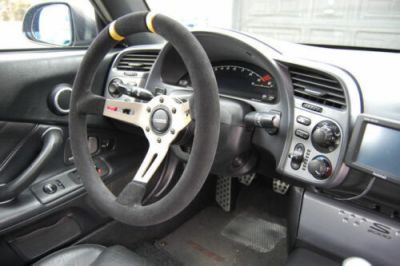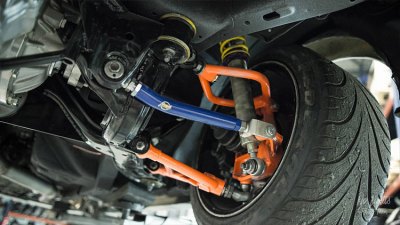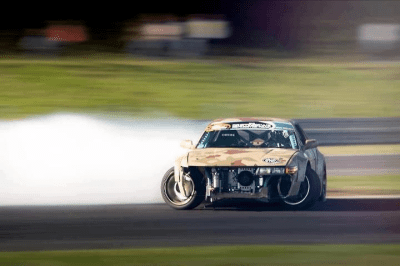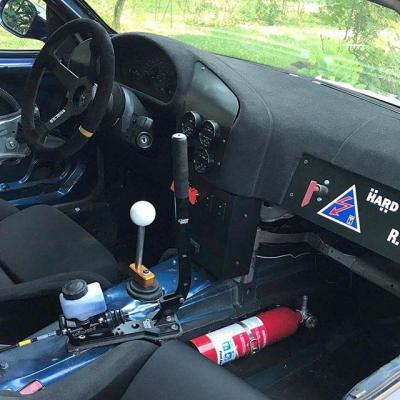Drifting is a hugely popular motorsport unlike any other, focusing on style and getting sideways rather than the pursuit of the fastest time between two points. It’s a challenge that places great demands on car and driver, and proper attention to setup to truly succeed. Here’s a guide to get your first drift build coming together.
Getting Sideways (And Back Again)
Drift cars are specialised beasts, and like any motorsport discipline, the demands of the sport shape the vehicle to suit. If you’re looking to drift, you’ll want to choose a project car with a front-engined, rear-wheel drive layout. While it’s somewhat possible to drift with other layouts, the act of kicking out the tail and holding a slide at speed is best achieved with the handling characteristics of such a vehicle. It all comes down to weight transfer and breaking traction at will. Of course, over the years, certain cars have become expensive on the second-hand market due to their drift prowess, so you may have to get creative if your first choice isn’t available at your budget. It pays to talk to the drifters down at your local track to get an idea of which cars in your area are the best bet for a drift build. Once you’ve got yourself a car, you can get down to installing mods!
Seats, Belts, And Steering Wheels

If you’ve ever been in a passenger car and tried cornering hard, you’ll be familiar with inertia trying to throw you out of the seat. Drifting is all about throwing the car sideways around corners, so you’ll be experiencing this multiple times every lap. Your average car seat is designed for comfort more than holding passengers in during extreme lateral manoeuvres, and so is a poor choice for drifting. You’ll find yourself sliding out of the seat or desperately trying to hang on to the steering wheel instead of focusing on getting the right lines through a bend.
Instead, you’ll want to install seats properly designed for racing use. Some factory seats from uprated sports models can have better bolstering that helps hold you in, but you can’t beat a proper racing bucket when it comes to drifting. You’ll want to pair it with a four- or five-point harness that feeds through the belt loops in the seat, which will help lock you in place and allow you to remain in control of the car during extreme manoeuvres. You may need to install a harness bar as well to provide proper hard mounting points, too.

Additionally, you may find your stock steering wheel isn’t well suited to drift use. Factory wheels, particularly modern types covered in switches and buttons and with fat spokes, can be difficult to use when the wheel is rapidly sawing left and right through fast transitions. Drift wheels are available which have a deep dish, allowing you to keep your hands wrapped around the rim while it spins, allowing better control in these situations. Fitting such a wheel may require a steering boss kit and airbag removal, however; tread carefully and enlist professional help if you’re not comfortable doing this yourself. Airbags can detonate suddenly if handled incorrectly and should be treated like the dangerous explosive devices they are.
Suspension

You’ll want to consider upgrading your suspension if you’re serious about carving up the drift circuit. Building a car that makes initiating and controlling drifts easy requires careful attention to suspension setup, particularly parameters like camber, ride height, and rebound settings. A set of adjustable coilovers is a great start, as well as finding an alignment shop that will set the car up to your needs. Your average Jiffy Lube isn’t the place to go; you’ll need to find the shop that doesn’t grimace when you hand over your sheet of desired settings.

Getting the right setup is too complicated to go into here, but great guides exist. You may find you need to invest in more upgrades in order to get the setup you want. Your car may benefit from adjustable control arms to get more camber, or aftermarket steering knuckles that allow for more steering angle. The latter is particularly important for more serious drifting; being able to wind on more steering angle allows the car to hold more drift angle without spinning out, and makes recovery from a bad situation more likely. A few bucks spent on knuckles may keep your car out of the wall and save you a bundle in front-end repairs. Other useful mods include sway bars that can help reduce body roll, and braces to stiffen different areas of the chassis for more predictable handling. Throwing a stiffer set of bushings in all your suspension arms can help tighten things up, too.
Differential

Drifting involves breaking traction at the rear wheels in a controlled fashion, and one of the primary ways this is done is by simply dumping enough power to break the tyres loose. Unfortunately, an open differential isn’t able to do this effectively to both wheels; when one wheel breaks loose, the differential will then only supply that wheel, and the other, with an equal and tiny amount of torque. Most cars come stock with an open differential, so this is one of the first upgrades for many drift builds.
Instead, you’ll need something that can put power down to both wheels. The cheapest option is to simply weld up the open differential so that both wheels are locked to rotate together. Alternatively, a spool can be installed in the rear end to do the same thing. These options come with the drawback of preventing the rear wheels spinning at different rates when going round corners, leading to tyre chirp when parking or in low-speed situations. It’s not a great option for a car that’s driven on the street, but is fine for a grassroots drifting build.
Alternatively, a limited-slip differential can be installed that allows slip under some conditions, but not others. These are better for handling in mixed conditions, particularly for cars that aren’t solely for drift use. However, the ability to lock and unlock the wheels together also gives them some benefits over welded diffs in terms of control of a car mid-drift. The best type for serious drift use is a 2-way clutch-pack type, which locks the wheels under acceleration and deceleration. A 1.5-way only locks half as strongly on deceleration, and can be more bearable for street use. Other LSD types, like torque-sensing (Torsen) models aren’t as suitable for drifting, and most Viscous LSDs have long ago failed and are now worthless open units.
Handbrake

A handbrake is a great way to initiate a drift, and all serious drift cars have them. Stock handbrakes often work by a small drum inside the rear hub, or by lightly actuating the stock disc brake pads. Some stock handbrakes are fine for getting started in drifting, others are too weak or inconsistent to be much help. They’re often cable-actuated, and stretch and wear over time can further degrade performance.
The gold standard for drifting is the hydro handbrake, which replaces the stock handbrake lever entirely. In its place is a large lever, often designed to sit up high next to the steering wheel, which actuates its own hydraulic master cylinder. This can be designed to either directly actuate the existing rear brake calipers, or instead connected to a second set of rear calipers solely for handbrake use. These setups allow the rear wheels to be easily locked up on demand for repeatable, accurate drift initiation lap after lap.
Tyres

Tyres are the interface between your car and the tarmac, and thus have perhaps the biggest impact on performance of any part of the car. Many people believe that drift cars must use very slippery tyres, due to their goal of breaking traction. However, at the top level, drift cars actually use incredibly soft tyres for maximum grip. This allows the cars to maintain control at incredibly high speeds and have more finesse when traction is broken. Sticky tyres are key to the speed and ferocity of modern drifting, with the drawback that they require huge amounts of power to break traction in the first place. This has been the major driver of increasingly wild engine setups in the drift scene, with nitrous and turbos pushing engines over the 1000 bhp mark.
However, if you’re starting up, this is exactly what you don’t want to do. Instead, try and get a few cheap, worn sets of street tyres in the size that fits your car. It takes time to learn drifting, and you’ll wear out a lot of tyres along the way. You’ll also want to be able to initiate a drift without needing huge power and speed to do so. Worn tyres are often available cheaply from tyre shops second hand who otherwise have to pay to haul them away. Their lower grip levels will also make learning the basics of drifting easier at lower speeds. Once you get more confident, you can begin to explore higher grip levels as your build improves along the way. That said, this only goes for rear tyres – keep the grippiest possible rubber on the front at all times! Without grip on the front end, you’ll have absolutely no luck keeping your car under control.
Conclusion
Drifting is a difficult skill to learn, and one that typically requires access to a skidpad or track to do so safely. Unlike other motorsports, it’s also far more particular about the type of car and setup required to do well. Any old car will go around a track, but your dad’s front-wheel drive minivan simply won’t drop huge clouds of smoke from the rears through a long sweeper. However, commit yourself to learning the skills, and build your car, and you’ll be well rewarded. Use your eyes and ears to observe what others get right and wrong, and you’ll do well!















*Eurobeat intensifies*
Nice image on this article, and a good introduction to drift mods as well! Another good option for rear tires are those really sketchy no-name Chinese tires. They’re just as good as a used pair for the rear!
I did no of the above and sent it with just a factory MX5 / miata VLSD, it was great for half a day at track until the tracks wall came out the victor of the day 😂 10/10 would do it again
Wish there was a place near Atlanta I could take my Suzuki Cappuccino it’s a nice little drifting car, even factory.
Oh, but it has https://www.caranddriver.com/news/a15357160/thank-you-for-smoking-ford-explains-the-focus-rss-drift-mode/
Rock proof windshields are also a good option, particularly if you use suburban streets as a track. Not much you can do about angry suburbanites with IR lasers though unless yo want to drive around in the dark with dark green glasses on…
You have people in suburban neighbourhoods trying to blind you?
No I have people doing drifting in the middle of the night right past houses with sleeping children. This is despite the fact that we are about 10 km from a dedicated raceway where they can do as much of that as they like.
I have sports bike assholes like that. My child can sleep in a warzone but my neighbour kids wake up every time. Come spring and they show up on their screaming death machines at midnight going at breack neck speeds, and there’s frigging highway ring around city just 5 minutes (more like 2,5 at their speeds) from us. We can call cops all we want its time they care about drunkards exiting bars than those murderous bastards. f@ck anyone who think public roads are for racing.
It is not just the noise issue as there is a very real risk of them going through the side of a person’s house if they get out of control and leave the road. Also the burning rubber from the tires produces a huge amount of really nasty smoke that is both carcinogenic and a potential asthma trigger. They could kill people.
Lee Gleason, the Debbie Downer of hackaday posters, why not just ignore the things you hate instead of telegraphing your phobias to the world? Oh but you need people to know about your narrow-mindedness.
Rap music? Not so much. Much more like figure skating.
Wasn’t this all started by Doc Hudson in Cars?
drifting was a thing waaay before Cars!
Dirt track speedway dates back to the 1920s, think dirt track for cars was a thing by WWII.
Generally rallying as a whole.
Ye olde dirt track racing were essentially crowded rallying on a closed circuit.
Driving on dry pavement with a locked differential is, uh, not advisable. Might be fine for drifting, but it’s a recipe for disaster on a public road.
…And on wet or icy pavement, it’s downright suicidal.
Two countries separated by a common language again.
In the UK driving on the pavement would be suicidal for pedestrians, there’s a phrase – keep death off the roads, drive on the pavement. The pavement being the path where people walk and the road being where the cars are supposed to go.
How many “drift builds” are s13s with no motor?
“Drifting” has been available at your local dirt oval for decades. It’s cheaper, safer, and more fun!
“How many “drift builds” are s13s with no motor?”
not too many, its not hard to throw a ls or any other sbc into a s13, s14, s15, rx8, miata.
Drifting is now available at some go kart tracks, hpde tracks and even quite a few big name tracks (depending on the organiser)
One of my tricks with my favorite scrapyard racer: Woven frame and rear axle supports. The real axle drifted freely on the springs, so we tied it in with (a *lot* of) bailing wire, which gave it some “give”. The frame had some of the same treatment; resulting in an *incredibly* nimble car.
Interesting… first instinct here would probably have been https://en.wikipedia.org/wiki/Panhard_rod from a bit of black iron pipe, but I was more interested in rally, so think in street legal.
I dont usually get into cars but when i do, I prefer the doors.
Good plan, keep it normal, if you dissipate into smoke and seep in through the vents, it’s a dead giveaway that you’re a vampire.
All this and not a single mention of the transmission choice? I’m no Vin Diesel but I feel like choice of transmission might have more influence on drifting than choice of steering wheel.
Manual, that is all.
Amen.
A slushbox CAN bet used.
Buuut not without modifications and expensive aftermarket bits.
Versus a crunchstick from a small truck with bubba’d adapter bellhousing, that can handle even a turbo’d LS or souped up OM606.
Supposedly also DSG’s, Buuut same thing as with slushboxes, and pretty much MUST be a wet clutch variant.
Because almost mandatory motorsports modifications for automatics and DSG’s are transmission coolers.
Though forget everything about CVT’s, it’ll just be ritualistic murder of them.
I once lived in Alaska and only bought 2 studded tires for the front of my Honda Civic. Driving on the ice road plowed on the river was a real drift driving experience (in more than just having the rear end sliding around). I imagine this would be a really fast way to get a good feel for getting in and out of a drift. Since I also (probably illegally) drove on the regular roads I had to gain a good feel for keeping it from drifting since it was really easy to loose control ! Fortunately it was the bush and the longest road was only a few miles long.
Sounds a lot like what I used to to when I was younger. Get fwd car, take a plastic pallet, cut into quarters, place one quarter under each rear tire, pull e-brake, then slide around. Generally it works best in freshly asphalted areas, and ideally this is always done under wet conditions to slow the erosion of the plastic.
I’m curious that no-one seems to mention switchable lockers as used by the 4×4 crowd, flick a switch and you have a 100% locked diff, flick it off you’ve got perfect street manners. It may be they’re not reliable switching under power / very high power, who knows.